Physical Address
304 North Cardinal St.
Dorchester Center, MA 02124
In the past decade, advances in cell biology have led to the development of anticancer agents that target specific molecular pathways. The National Cancer Institute (NCI) defines targeted therapies as “drugs or substances that block the growth and spread of cancer by interfering with specific molecules involved in tumor growth and progression.” Targeted therapies are now commonly used in cancer treatment and it is vital that their kidney toxicities be recognized and investigated. Early reports suggest that targeted therapies are associated with a range of toxicities from hypertension (HTN) to acute kidney injury (AKI). Table 17.1 and Fig. 17.1 summarize the renal effects of targeted therapies. Many of these drugs, however, have been associated with significant kidney complications, ranging from electrolyte disorders to AKI requiring dialysis. This chapter will cover renal toxicities seen with several classes of molecularly targeted and biologic agents, including preventive strategies. Immune-mediated renal toxicity associated with checkpoint inhibitor immunotherapy (ipilimumab, pembrolizumab, nivolumab, duravalumab, atezolizumab) is discussed in Chapter 18 .
| Name of Agent | Mechanism of Action of the Targeted Therapy | Reported Nephrotoxicities |
|---|---|---|
| Bevacizumab | VEGF inhibitor | HTN, proteinuria, nephrotic syndrome, preeclampsia-like syndrome, renal limited TMA |
| Aflibercept | VEGF inhibitor | HTN, proteinuria |
| Sunitinib | Multi-kinase TKI | HTN, proteinuria, MCD/FSGS, AIN, chronic interstitial nephritis |
| Pazopanib | Multi-kinase TKI | HTN, proteinuria |
| Axitinib | Multi-kinase TKI | HTN, proteinuria |
| Sorafenib | Multi-kinase TKI | HTN, proteinuria, MCD/FSGS, AIN, chronic interstitial nephritis, hypophosphatemia |
| Imatinib | Cellular TKI (BCR-ABL) | ATN, HTN, hypocalcemia, hypophosphatemia |
| Dasatinib | Multi-kinase TKI | Proteinuria |
| Nilotinib | Multi-kinase TKI | HTN |
| Ponatinib | Multi-kinase TKI | HTN |
| Cetuximab | EGFR inhibitor | Hypomagnesaemia, hypokalemia, AKI, hyponatremia, glomerulonephritis |
| Panitumumab | EGFR inhibitor | Hypomagnesaemia, AKI, hypokalemia |
| Erlotinib | EGFR inhibitor | AKI, hypomagnesaemia |
| Afatinib | EGFR inhibitor | AKI, hyponatremia |
| Gefitinib | EGFR inhibitor | AKI, hypokalemia, fluid retention, minimal change disease, proteinuria |
| Vemurafenib | B-RAF inhibitor | AIN, ATN, hypophosphatemia, Fanconi syndrome |
| Dabrafenib | B-RAF Inhibitor | AIN, ATN, hypophosphatemia, nephrotic syndrome (in combination with MEK inhibitor) |
| Crizotinib | ALK inhibitor | ATN, renal cysts |
| Ipilimumab | CTLA-4 inhibitor | AIN, MN, MCD, hyponatremia, TMA |
| Nivolumab | PD-1 Inhibitor | AIN, ATN, podocytopathies |
| Pembrolizumab | PD-1 Inhibitor | AIN, ATN, podocytopathies |
| Temsirolimus | mTOR inhibitor | ATN, FSGS |
| Carfilzomib | Proteasome inhibitor | Prerenal, ATN, TMA |
| Bortezomib | Proteasome inhibitor | TMA |
| Lenalidomide | Immunomodulator | Fanconi syndrome, AIN, MCD |
| Trametinib | MEK inhibitor | AKI, nephrotic syndrome (in combination with BRAF) |
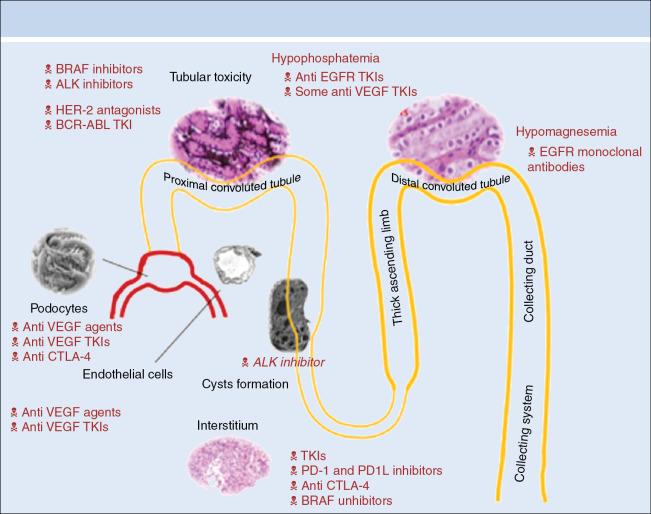
Angiogenesis, the process by which new blood vessels form, plays an integral role in tumorigenesis and is mediated by vascular endothelial growth factors (VEGF). Accordingly, drugs that inhibit this pathway have emerged as an effective anticancer therapy in various malignancies, such as lung, breast, colon, renal cell carcinoma, and ovarian cancer. VEGF inhibition works by several proposed mechanisms, including monoclonal antibodies against the VEGF molecule, small molecule tyrosine kinase inhibitors (TKIs) of the VEGF receptors, soluble decoy receptors, and ribozymes that target VEGF messenger ribonucleic acid. Bevacizumab, ramucirumab, and aflibercept (a soluble decoy receptor of VEGF) are monoclonal antibodies that bind to the VEGF molecule, preventing it from binding to the receptor, thus inhibiting endothelial cell proliferation and vessel formation, whereas the small molecule TKIs (sunitinib, sorafenib, pazoponib, axinitib, cabozatinib, lenvatinib, regorafanib, and vendatinib) block the intracellular domain of VEGF. ,
Proteinuria is a class effect of all VEGF inhibitors; however, the exact mechanism is unclear. VEGF plays an important role in the regulation of renal vascular endothelium and maintenance of normal kidney function. VEGF is found on both endothelial cells and podocytes (renal epithelial cells) among other cells, and the interaction between the glomerular endothelial cells and podocytes via the VEGF pathway is necessary to maintain glomerular filtration by preserving the integrity of the glomerular slit diaphragm. It has been theorized that VEGF inhibition can lead to podocyte injury and can therefore lead to proteinuria. Histologic findings in these patients can show renal limited thrombotic microangiopathy (TMA) ( Fig. 17.2 ) and in some cases minimal change disease (MCD) or focal segmental glomerulosclerosis (FSGS) ( Fig. 17.3 ). Preexisting kidney disease and renal cell carcinoma may be predisposing factors. Treatment can be continued in those cases where proteinuria is not in the nephrotic range, and HTN and proteinuria can be aggressively managed with angiotensin-converting enzyme inhibitor (ACEI) or angiotensin receptor blocker (ARB) inhibition. AKI, especially when caused by TMA, is an indication for drug discontinuation.
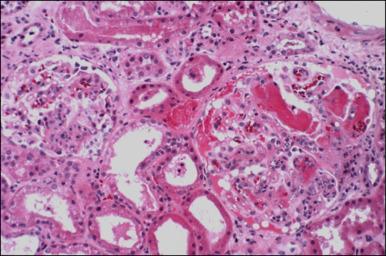
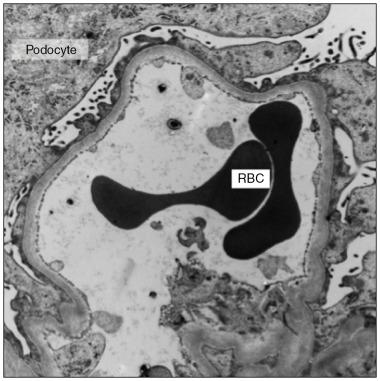
HTN frequently accompanies proteinuria. Several mechanisms have been proposed in the pathogenesis of HTN, including decreased nitrous oxide and microvasculature rarefaction leading to nitrous oxide dysregulation ( Fig. 17.4 ). The adverse effects of both proteinuria and HTN were initially described with bevacizumab, the first anti-VEGF drug introduced to clinical practice. The HTN appears to be dose dependent, as observed in several studies, with one study reporting the relative risk of HTN of 3.0 in low-dose bevacizumab (3, 5 or 7.5 mg/kg) as compared with high-dose (10 or 15 mg/kg). Another study by Yang et al. demonstrated that the rate of HTN was 3% in the low-dose bevacizumab group (3 mg/kg), compared with 36% in the high-dose cohort (10 mg/kg). Similarly, the HTN reported with small molecule TKIs appears to be dose dependent as well. Interestingly, the development of HTN may portend a better response to therapy, and therefore should encourage physicians to continue treatment while managing the blood pressure. The choice of antihypertensive agents should be individualized with ACEIs or ARBs as first-line options and calcium channel blockers as a reasonable second line.
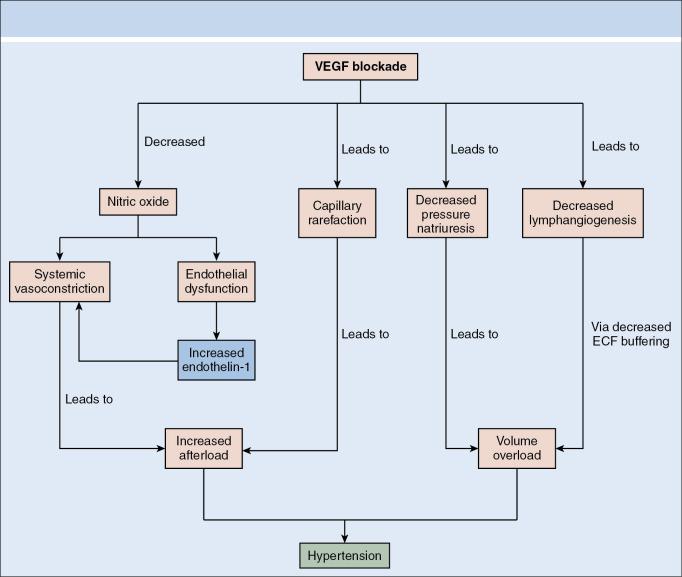
A small number of patients develop more severe kidney disease, manifested by nephrotic range proteinuria and AKI. Unfortunately, few undergo diagnostic kidney biopsy. Review of reported cases highlights that the most common histopathologic lesion, acute TMA, has been reported in patients with advanced cancers treated with bevacizumab and VEGF trap (aflibercept). Other anti-VEGF therapy induced kidney lesions included FSGS, mesangioproliferative glomerulonephritis, cryoglobulinemic glomerulonephritis, immune complex glomerulonephritis, glomerular endotheliosis, and acute interstitial nephritis (AIN). All patients developed proteinuria, whereas half developed HTN or AKI. In most of the cases, kidney function normalized or stabilized, proteinuria resolved, and blood pressure control improved after discontinuation of the agent. , Fig. 17.5 summarizes the VEGF effects on blood pressure and proteinuria.
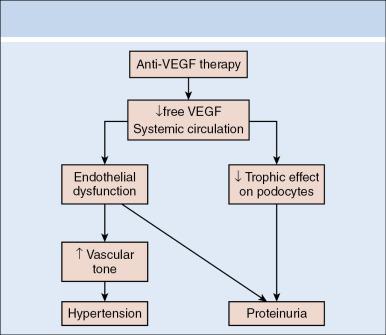
Protein kinases are important mediators of the signal transduction process and regulate cell proliferation, differentiation, migration, metabolism, and antiapoptotic signaling. The most important protein kinases are the serine/threonine and tyrosine kinases, which are characterized by their ability to catalyze the phosphorylation of serine/threonine or tyrosine residues in proteins, respectively. There are two types of tyrosine kinases: receptor and cellular tyrosine kinases. Receptor tyrosine kinases consist of an extracellular ligand binding domain, a transmembrane domain, and an intracellular catalytic domain. They are activated by ligand binding to the extracellular domain. Cellular tyrosine kinases play a role in the downstream signal transduction pathway, in the cytoplasm or nucleus. Tyrosine kinases are involved in several steps of neoplastic development and progression; the signaling pathways normally prevent unregulated proliferation; however, these pathways are usually genetically altered in cancer cells, thus allowing for constitutive activity of the tyrosine kinases and unregulated cell growth and proliferation. Thus TKIs are effective anticancer agents, because they interfere with this unregulated process. Receptor TKIs target the epidermal growth factor receptor (EGFR), platelet derived growth factor receptor (PDGFR), and vascular endothelial growth factor receptor (VEGFR), whereas cellular TKIs can target breakpoint cluster region–abelson (BCR-ABL) (imatinib) and Bruton’s kinase (ibrutinib). These agents could target single receptors, such as EGFR (geftinib), or could be multitargeted, such as sunitinib, which targets VEGFR, PDGFR, kit, Flt3, and RET. Some of the renal side effects of common TKIs, such as sunitinib and sorafenib, were discussed earlier with anti-VEGF therapy, as their effects are similar on the kidney.
Like anti-VEGF drugs, the small molecule TKIs of the VEGFR family (sunitinib, sorafenib, pazopanib, axitinib, cabozantinib, lenvatinib, and vandetanib) are also potent inhibitors of angiogenesis, and thus have a similar adverse effect profile. Sunitinib and sorafenib target multiple receptor kinases including VEGFR, PDGFR, c-kit among others. Sunitinib, sorafenib, pazopanib, and axitinib have known effects of HTN, proteinuria, TMA, and chronic and acute interstitial nephritis. Sorafenib is also known to cause hypophosphatemia and hypocalcemia, thought to be related to pancreatic dysfunction from the drug leading to vitamin D malabsorption and secondary hyperparathyroidism. Table 17.2 summarizes reported renal toxicities specific to VEGF inhibitors.
| VEGF/R Antibodies | Renal Toxicities Reported |
|---|---|
| Bevacizumab | HTN, proteinuria, preeclampsia-like syndrome, renal limited TMA |
| Aflibercept | HTN, proteinuria |
| RECEPTOR TKIs, VEGF FAMILY | |
| Sunitinib | HTN, proteinuria, MCD/FSGS, AIN, chronic interstitial nephritis |
| Pazopanib | HTN, proteinuria |
| Axitinib | HTN, proteinuria |
| Sorafenib | HTN, proteinuria, MCD/FSGS, AIN, chronic interstitial nephritis, hypophosphatemia |
| Regorafenib | HTN, hypophosphatemia, hypocalcemia, proteinuria, AKI |
| Vandetanib | HTN, hypokalemia, hypocalcemia |
| CELLULAR TKIs, BCR-ABL | |
| Imatinib | ATN, rhabdomyolysis, hypophosphatemia |
| Nilotinib | HTN |
| Ponatinib | HTN |
| Dasatinib | Rhabdomyolysis, ATN, proteinuria, TMA |
| Bosutinib | Hypophosphatemia |
Lenvatinib also targets several tyrosine kinases including RET, KIT, VEGFR, and PDGFRA. No significant renal toxicities have been reported with this drug. Regorafenib is associated with several electrolyte abnormalities, including hypophosphatemia, hypocalcemia, hyponatremia, and hypokalemia. However, these abnormalities are usually mild to moderate and do not require dose adjustments or interruptions in treatment. As with other VEGF inhibitors, there is a significant incidence of HTN. In the initial trial evaluating regorafenib as monotherapy for previously untreated metastatic colorectal cancer, the incidence of HTN was 28%, with 7% reported as grade 3. The incidence of proteinuria was lower at 7%, with 1% reported as grade 3. Unlike bevacizumab, the HTN associated with regorafenib does not appear to be dose dependent. A systematic review by Wang et al. evaluated 1069 patients from five clinical trials. The incidence of all grade and high-grade HTN were 44.4% and 12.5%, respectively. An analysis of the U.S. Food and Drug Administration (FDA) Adverse Event Reporting System (FAERS) database confirmed HTN as the most common adverse event (57 cases of 125 total cases of regorafenib-related toxicity), followed by AKI (40 cases) and hypophosphatemia (8 cases).
Vandetanib targets VEGFR2, EGFR, and RET. This agent has also been associated with several electrolyte disturbances, such as hypocalcemia, hypokalemia, hyponatremia, and hypercalcemia. Similar to other VEGF inhibitors, there is also a significant incidence of HTN. In a phase 2 trial of vandetanib, in locally advanced or metastatic differentiated thyroid cancer, HTN was seen as frequently as 34% of cases. , Analysis of the FAERS database identified a total of 57 adverse renal events for vandetanib between 2011 and 2015, with the majority identified as renal impairment (defined as proteinuria, AKI, elevated serum creatinine +/- nephritis, 30 cases) and HTN (21 cases), with the remainder being electrolyte disturbances. Vandetanib has also been shown to have an inhibitory effect on several human renal transporters, such as multidrug and toxin exclusion (MATE)-1 and MATE-2, which are responsible for drug clearance. Inhibition of these transporters at the apical membrane of the tubular cells may lead to increased concentrations of the drug within renal tubular epithelial cells, resulting in increased nephrotoxicity of other coadministered agents, such as cisplatin. ,
B cell lymphoma (BCL)-2 is a key regulator of apoptosis. Inhibitors of this pathway are emerging as effective therapies for various hematologic malignancies. Venetoclax is a potent selective inhibitor of BCL-2, and has been approved for the treatment of refractory chronic lymphoid leukemia (CLL), both as monotherapy and in combination with cytotoxic chemotherapy. There is a particularly high incidence of tumor lysis syndrome, which can lead to AKI and subsequent electrolyte abnormalities. In a phase 1 dose escalation study to assess safety and pharmacokinetic profile, 56 patients received active treatment in one of eight dose groups per day; in an expansion cohort, the dose escalation was adjusted to a stepwise ramp up. Clinical tumor lysis syndrome occurred in three of 56 patients in the dose escalation cohort but was not present after adjustments to the dose escalation schedule were made in the expansion cohort. Thus a stepwise dose escalation strategy ( Fig. 17.6 ), with close monitoring of renal function and electrolytes, is advised to reduce the risk of tumor lysis syndrome.
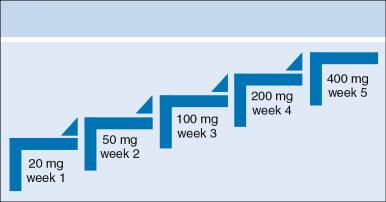
The bcr-abl oncogene, present in 95% of patients with chronic myelogenous leukemia (CML), codes for the constitutively activated tyrosine kinase that is implicated in the pathogenesis of this disease. The introduction of BCR-ABL inhibitors have changed the landscape of CML, improving overall survival and inducing higher rates of complete cytogenetic response and major molecular response. Several small molecule inhibitors of BCR-ABL exist, including imatinib, dasatinib, nilotinib, bosutinib, and ponatinib.
Imatinib is a first generation TKI that targets BCR-ABL, KIT, and PDGFR. Both AKI and chronic kidney injury have been reported in patients treated with imatinib. In one study of 105 CML patients, 7% of patients developed AKI and 12% patients developed chronic kidney disease (CKD). The mean decrease in estimated glomerular filtration rate (GFR) was 2.77 mL/min/1.73 m 2 per year. Potential mechanisms of renal injury include tumor lysis syndrome and acute tubular injury; sometimes an isolated Fanconi syndrome develops. Rhabdomyolysis has also been reported. The kidney injury does appear to be dose dependent, as seen with renal cell cancer treatment, with higher doses associated with a higher incidence of renal tubular damage. Two common electrolyte abnormalities reported are hypocalcemia and hypophosphatemia. In one case series, the incidence of hypophosphatemia was close to 10% and associated with low calcium and 25-OH vitamin D levels. The underlying mechanism for hypophosphatemia is unclear, but may be related to the inhibition of tubular reabsorption of phosphorus.
Dasatinib is a second generation TKI used in imatinib-resistant CML. It also has effects on PDGFR and KIT. There have been several cases of AKI reported with the use of this drug, including one patient who developed rhabomyolysis, and another patient who developed thrombotic thrombocytopenic purpura. In addition, there is a 5% incidence of proteinuria with this agent. Nephrotic syndrome has also been described. , Of the BCR-ABL TKIs, dasatinib is the only one associated with proteinuria. In all cases the proteinuria resolved upon discontinuation of the drug or switching to imatinib.
Nilotinib is also an inhibitor of BCR-ABL, c-KIT, and PDGFR. It has been associated with HTN. The effect of nilotinib on CKD was evaluated in animal models, where it has been shown to be nephroprotective. Interestingly, treatment with nilotinib significantly decreased renal cortical expression of profibrogenic genes (such as IL-1B and monocyte chemotactic protein-1 ), which correlated with tubulointerstitial damage; in addition, nilotinib significantly prolonged survival. These results suggest that nilotinib may limit the progression of CKD.
Bosutinib is a dual TKI that targets the ABL and SRC pathways that is approved for the treatment of refractory CML. The only renal toxicities reported with this agent are hypophosphatemia and an apparently reversible decline in GFR. Ponatinib is a multitargeted TKI, with VEGF being one of the molecular targets. As such, the renal toxicities that are a class effect of VEGF can be seen with this agent.
Mutations that drive signaling pathways critical to tumor growth are attractive molecular targets for cancer therapy. The mitogen-activating protein kinase (MAPK) pathway is one such pathway, estimated to be dysregulated in about 50% of malignancies. RAF is a kinase along this pathway that, once activated, phosphorylates mitogen-activated protein kinases (MEK) and activates MAPK, which in turn stimulates cell growth. Mutations in v-RAF murine sarcoma viral oncogene homolog B (BRAF), most commonly a valine-to-glutamic acid substitution at codon 600 (V600E), have been demonstrated in approximately 50% of patients with melanoma. Vemurafenib, an inhibitor of mutated BRAF, has shown significant improvements in survival when compared with standard therapy. The initial phase III study did not report significant renal toxicity. In 2016 Wanchoo et al. did a comprehensive review of AKI with BRAF inhibitors; the most common findings were acute tubulointerstitial damage and decreased GFR in 1 month and some nonnephrotic range proteinuria. The mechanism of AKI is not clear; however, kidney biopsies, when done, showed acute tubulointerstitial damage and interstitial fibrosis ( Fig. 17.7 ). Multiple other publications have reported various renal toxicities. One series of eight cases from France demonstrated decrease in GFR, whereas another case reported Fanconi syndrome with severe hypokalemia, which improved after interruption of therapy. Another study showed that vemurafenib induces a dual mechanism of increase in plasma creatinine with both an inhibition of creatinine tubular secretion and slight impairment in kidney function. However, this adverse effect is mostly reversible when vemurafenib is discontinued and should not dissuade physicians from continuing treatment if effective. Finally, an analysis of the FAERS database reported 132 cases of AKI, more commonly identified in older men. There were 13 reported cases of AKI with dabrafenib in the same review period. Eight cases of electrolyte disorders were reported (hypokalemia and hyponatremia); however, no cases of hypophosphatemia were found, contrary to prior reports.
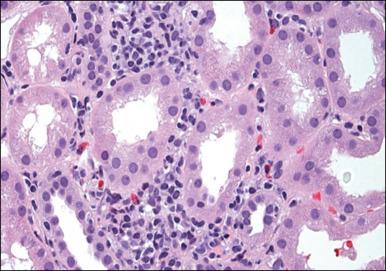
Become a Clinical Tree membership for Full access and enjoy Unlimited articles
If you are a member. Log in here